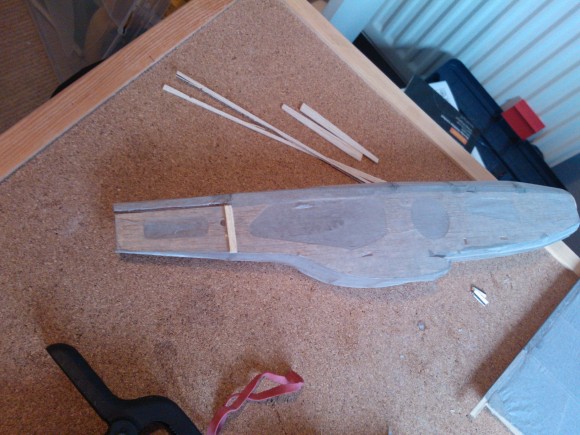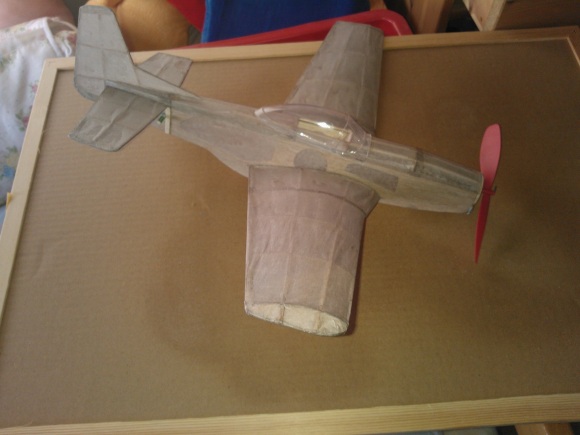During the covering of the wings, it became clear that the left wing was better built than the right. (There’s a point on the wing where there are two ribs side by side, and on the left wing they are identical, but on the right one rib rises a millimetre or so above the other towards the trailing edge of the wing.) Hopefully this won’t cause major problems. If it does, there is a solution – namely, strip off the tissue, sand level and re-cover.

After all of this came the shrinking stage. I had already been advised to leave the tail surfaces out of this and simply to seal them with the glue and water.
I shrank the fuselage, but unfortunately the tissue was quite slack in a couple of areas (due to some sloppy covering I expect) and so there are some wrinkles in the tissue even after shrinking.
At this point, things started to go slightly wrong.
Firstly, whilst sealing the tail surfaces, the tissue from either side stuck together. After posing the question on the Guillow’s forum, I was reassured that it won’t affect how the model flies, but it has left dark, translucent patches on the surfaces which mean that even before construction is completed, it looks grubby.
Secondly, after spraying the wings with water in the bathroom, I carried them back to Construction Central (also known as the spare room) pinned to my cork board. Watching the board carefully so as not to damage the wings, I sat down on the bed…. and also on the tail end of the fuselage. D’oh! Luckily, the fuselage itself was virtually undamaged, but I did manage to break the cocktail sticks I was using as a peg to hold the rubber band motor in place, and also weaken the mounting hole.
However, this was not the end of the problems. Reinforcing the hole with scrap balsa would potentially add too much weight behind the ideal centre of gravity, so I decided to drill myself a new hole a few millimetres away from the old one. I was smart enough to realise that the original hole was placed where it was to benefit from the nearby fuselage former so I decided to place my new hole in a similar position. However, despite measuring carefully, I clearly didn’t do it carefully enough. After drilling the new holes I inserted another cocktail stick only to find that it wasn’t level when viewed from above (one hole was nearer the tail than the other. The problem with this (I think) is that as the tension increased in the rubber band during winding, it would slip to the side nearer the nose and increase the stress on the wood on that side and probably tear a wider peg-mounting hole.
At this point, I feel as though more has gone wrong with this build than with the Hurricane. I’ve certainly made more mistakes. This is pretty frustrating considering that I had set myself the lower target of simply trying to make it fly, rather than look like a beautiful model. It will be quite an achievement to get it all completed and balanced at this rate!









